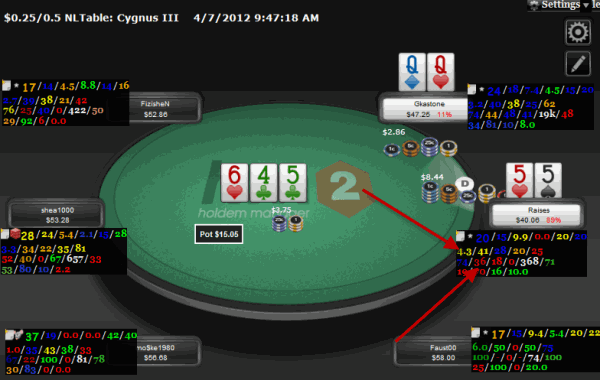Aggressive players with position against me hurt my winrate during yesterday’s play at 50NL poker tables. I lost almost 4 buy-ins in Expected Value by not playing well and trying to recoup my losses. At one point I managed to show a profit, but quickly gave it back and decided it would be a 3-hour session, due to family business. The plan for today is to play some big Sunday’s tournaments like the Pokerstars Warm-up and still complete a 4-hour poker session at micro stakes. Only this time I’ll try to avoid making the same mistakes as last Sunday, when I added more tables than I should.

If you have been playing poker, I’m sure the following scenario has come up several times. You open with a premium pocket pair (QQ+), you get called by a poker player at last positions and the flop is a very wet board with straight and flush draws. You still hold an overpair and your continuation bet is quickly raised by the villain. You are out of position against a pretty aggressive poker player and not sure what to do against his raise. If you are using a poker HUD, checking some stats might help you make a better decision. For example, when the button raised in the hand shown in the image below, I noticed two of his personal stats.

- Aggression Factor: 4.3
- Flop Fold to Continuation Bet: 36%
Maybe aggression factor is a general statistic that doesn’t help much. Still, it’s well into the upper limits of a proper poker strategy, defining the villain as a very aggressive player. The best strategy against super aggressive poker players is to call down with value hands letting him do the betting – including many bluffs and bad hands – or attacking back with bluffs.
The second stat is more important in this occasion. The ideal range of Flop Fold to Continuation Bet stat is 48-63% with anything below 40% or above 68% being a serious poker leak. In simple words that 36% figure meant that he might be semi-bluffing with a flush or straight draw more often than raising with a set, a made hand or another overpair. That’s why I should not reraise him and call his shove on the flop, which I did. Perhaps I’m results-orientated but the best poker strategy should have been calling his raise and evaluate the turn. The next card was a King, which he would obviously bet again and I would have an easy decision, although acting a bit weak with my Queens.
The only detail that is in my favor is the fact that no Queen was a club. If I held a card of clubs, it would have been one more reason to call instead of raise, cutting down their odds of hitting their possible flush draw. It’s one of those poker hands when you feel lost, but you should not. You must have decided from the beginning how to react in any possible reaction coming from certain villains and stick to that strategy. If aggressive poker players give you trouble out position, maybe it’s time to tighten up and become more passive but at the same time excel your (re)bluffing abilities.






